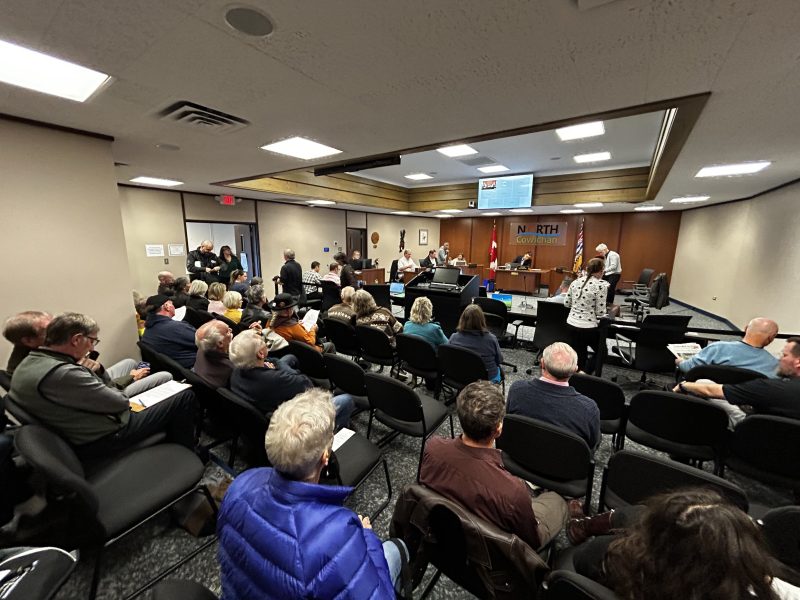
In 2022, the living wage increased in British Columbia to record highs, with jumps in housing and food costs driving the change.
Sitting at $24.08 an hour, Metro Vancouver saw the highest living wage increase since these annual calculations began in 2008, according to a recent report from the Canadian Centre for Policy Alternatives and Living Wage for Families B.C. Meanwhile, the living wage in Victoria has now surpassed Vancouver and sits at $24.29 an hour.
While communities across B.C. saw living wage increases between 17 and 25 per cent between 2021 and 2022, experts say the drastic jump has to do with many factors, including inflation but also more accurate calculations that better reflect the true cost of supporting a family.
But the fact remains that the living wage — a calculation used to determine the bare minimum that a family of four, including two parents and two children, needs to make to get by — is increasing. In response, advocates are calling for governments and employers to make changes to better support residents in B.C.
“It really is that wages aren’t keeping up more than [that] people are being extravagant in their spending,” says Iglika Ivanova, senior economist with the Canadian Centre for Policy Alternatives and co-author of the 2022 living wage report. “It’s obviously important to have financial literacy and to not be extravagant if you can’t afford it, but there’s limits to what individuals can do.”
Living wage a ‘powerful tool,’ but not perfect
Living wage is the hourly amount that each of two parents with two children need to make to cover basic costs. Expenses considered in the calculation include food, clothing, shelter, internet, transportation, child care, health care, parents’ education and a modest contingency fund. The calculation for the living wage also takes government taxes, credits, deductions and subsidies into account.
“It kind of captures the interplay between the labour market and the public programs that are available,” Ivanova says.
In 2022, researchers calculated the living wage for 22 different communities across B.C. and found that minimum wage in the province, $15.65 an hour, is less than living wage in each of the 22 communities and nearly $10 less in some. The factors affecting living wage in each community varied, with residents in some places paying more for shelter and child care while those in other communities paying more for transportation or food.
“The living wage is a powerful tool to ensure paid work results in a standard of living that is well above the poverty line and enables a life that is about more than a constant struggle to get by,” the living wage report says.
However, the living wage reflects a conservative, bare bones budget that doesn’t include things like home ownership, loan or interest payments, retirement savings, future education savings, or anything beyond minimal recreation, entertainment or holiday costs.
The calculation for living wage was also developed in 2008 to reflect the most common family type at the time — two parents with two young children. Ivanova says having young children is a particularly expensive time for families, especially with child care costs. But since 2008, government policies have changed to reduce the cost of child care through various benefits and programs.
Those who may feel left out of the living wage calculation include single individuals or folks without children who don’t qualify for various child care benefits that have been introduced over the last decade. Ivanova says the Canadian Centre for Policy Alternatives will investigate how to include residents who don’t fit into the typical family structure next year.
Data for living wage calculations also isn’t perfect, with various data sets available — or not available — in different communities for things like shelter, child care, food and transportation costs.
Employers encouraged to consider living wage
The living wage report says this calculation is “first and foremost a call to employers to pay both direct and contract employees wages sufficient to support families.”
Employers are encouraged to consider the wages of their lowest-paid workers and how far those earnings could go in some of the province’s most expensive regions. Increasing employee wages is a direct way to support poverty reduction and the pandemic response in B.C., the report says.
There are nearly 400 certified Living Wage Employers in the province, the report says. And 14 local governments have adopted living wage policies as of October 2022. Living wage employers include small businesses, non-profit organizations, unions and cooperatives.
Ryan Watson, administrative assistant with Social Planning Cowichan who helped lead the living wage calculations in the Cowichan Valley region, notes that workers making a higher wage tend to spend it in their communities, helping the local economy. He says that businesses that may not be able to increase wages can support employees financially by offering other things like benefits, flexible schedules and more.
“Even things like offering discounts on their own products or offering personal days and flexible schedules … taking into account working parents … are quick and easy steps that they can take to work up to living wage,” Watson says.
Ivanova says the living wage calculation is based on the assumption that there are no benefits for employees outside of the statutory minimums required by law. If an employer provides benefits outside of those minimums — like more paid sick time or vacation days — it reduces the living wage.
“It helps improve the quality of life of people,” Ivanova says. “So what we’re encouraging employers to do is to look at providing benefits if they can.”
New calculations more accurately reflect rise in shelter costs
Until last year, data for shelter costs wasn’t as accurate as it could be and Ivanova says that’s one reason for the stark increase in living wage in 2022.
“One of the challenges is, how do we properly factor the cost of rent, because there isn’t actually very good data that’s consistent across the province,” Ivanova says.
When the first living wage report was published in 2008, Ivanova says it seemed that high rents were an urban issue, mainly in greater Vancouver and Victoria, but that has changed over the last decade. Smaller communities are also seeing high rent costs — particularly in newly-built units.
The data set that was being used up until 2022 came from the Canada Mortgage and Housing Corporation, but Ivanova says it didn’t give a full picture of rent costs. The data from CMHC aggregates what new renters are paying with the rent that long-term tenants — who benefit from caps on rent increases — are paying. But that skews the numbers, as the difference between new and long-term rents has “sharply widened,” the report says.
The CMHC data also only comes from primary, purpose-built rentals like suites in apartment buildings. However, the report says the secondary rental market — which includes renting privately-owned condos or basement suites — has “grown significantly” since 2008 but is not reflected in the figure for median rents.
“As a result, the CMHC data on primary rental market median rents became an increasingly less reliable measure of the rents families are paying, and it now no longer reflects a realistic rent budget for a family with two young children (and likely hasn’t for the last few years),” the living wage report says.
For the 2022 report, Ivanova says extra calculations were performed to update the estimate for shelter costs and better reflect the rental situation in the province. This brought a large increase to the living wage compared to last year, but it’s because the true cost of rent has been previously underestimated.
Food is the second-highest cost, after rent
Food is now the second-most expensive item in the living wage budget, moving up from third place in previous years, the living wage report says.
The cost of food is calculated by determining the cost to purchase Health Canada’s Nutritious Food Basket, which includes healthy foods but doesn’t consider dietary needs, cultural food preferences and the cost of condiments and spices.
According to the living wage report, the latest numbers from B.C.’s food costing report — which has yet to be published — show that the price of groceries needed to feed a family of four is rising faster than the estimate of food inflation from Statistics Canada.
One of the reasons why the living wage in Victoria has now surpassed the living wage in Vancouver is because of the increased cost of food on Vancouver Island, an article from Living Wage for Families B.C. says.
But Watson says all of Vancouver Island used the same costing data for food. He points out that food costs vary based on which Island community a person lives in and notes that someone may have to drive further to find affordable food, impacting their transportation costs.
“That’s perhaps another blind spot for the calculation in terms of available data,” Watson said in an email to The Discourse.
Smaller communities may not be cheaper to live in
Ivanova says that during the COVID-19 pandemic, many people moved away from urban centres and into smaller communities for various reasons, including affordability and a desire for more space. As companies have transitioned to hybrid at-home and in-office work models, she says “big city wages” are making their way into smaller communities, driving up the cost of housing.
“Because there’s more people wanting to rent or buy … and they can afford to pay higher rents or more for a house, that pushes the prices,” Ivanova says. “That’s why we’re seeing this catch-up in rent and housing costs across the province in smaller areas … it’s partially people escaping the big city because they can afford to.”
But moving to smaller communities still comes with a tradeoff. Smaller communities may not have the same transit availability as urban centres, meaning people will pay more to get around.
And, as Watson noted, the cost of goods like food can be more expensive in smaller communities.
In the Cowichan Valley, Watson says they were able to include a second vehicle in the living wage calculation for the first time last year. Traditionally, the transportation calculation was made using the cost of one vehicle and a transit pass.
“It doesn’t really represent a realistic scenario in our region,” Watson says, noting that the addition of a second vehicle to the calculation contributed to the increase in living wage in the Cowichan Valley, which sits at $23.53 per hour.
Government programs needed
The provincial government in B.C. introduced policy changes to address the cost of living and improve affordability through child care investments, the elimination of Medical Services Plan premiums and more. The living wage report says this significantly decreased the living wage in 2019. But inflation and the rising cost of living have now cancelled out the benefits from these government programs.
“Tying minimum wage increases to the general inflation rate measured by Statistics Canada’s Consumer Price Index is clearly far from sufficient,” the report says, noting that B.C.’s Fair Wages Commission is advising the province on how to address the gap between minimum wage and living wage, but the report has not been released yet.
Investments are being made to reduce child care fees and a new federal dental benefit for children is available, but the living wage report says rising rent costs will surpass any savings from these programs.
“I think what we need to look at clearly is both an increase in the minimum wage and government programs and investments in the kind of services that will reduce pressure on family budget,” Ivanova says. “So housing, for example, really jumps out as a point of tremendous strain for family budgets across the province.”
Housing investments could look like creating more affordable, below-market housing to ensure people making low wages can support themselves, Ivanova says.
Watson says improving transit infrastructure to encourage cost-effective ways of getting around could also help.
“The fact that we aren’t able to rely on public transit infrastructure in the Cowichan Valley really says a lot,” Watson says. “I think [public transit infrastructure] would go a long way to increasing affordability.”
The living wage report says direct government transfers like the Federal GST Credit, B.C. Rental Assistance Program and more can help put more money in people’s pockets, but most are eliminated once a family or individual reaches an income level that is below the living wage in many communities.
The report calls on provincial and federal governments to review low-income transfers and credits regularly so that the eligibility to receive them, and the amounts provided, keep up with cost of living.
“When government transfers fail to keep up, the families hardest hit include workers who are already marginalized in the labour market, including single mothers, Indigenous people and recent immigrants,” the report says.
This reporting was made possible through the financial support of Coast Capital, a member-owned cooperative. The article was produced with full editorial independence; Coast Capital was not involved in the story selection, reporting and editing process.



